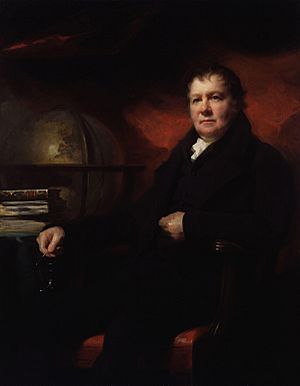John Playfair facts for kids
Quick facts for kids
John Playfair
FRS, FRSE
|
|
|---|---|
 |
|
| Born | 10 March 1748 Benvie, Forfarshire, Scotland
|
| Died | 20 July 1819 (aged 71) Burntisland, Fife, Scotland
|
| Resting place | Old Calton Burial Ground |
| Alma mater | |
| Known for |
|
| Scientific career | |
| Fields | Mathematics, natural philosophy, geology |
| Institutions | University of Edinburgh |
| Influences | James Hutton |
John Playfair (born March 10, 1748 – died July 20, 1819) was a Scottish scientist, mathematician, and professor. He taught natural philosophy, which is what we now call physics, at the University of Edinburgh.
He is famous for a few important things:
- His book, Illustrations of the Huttonian Theory of the Earth (1802), explained the ideas of James Hutton. This book helped spread the idea of uniformitarianism. This is the idea that the same natural processes we see today (like erosion or volcanoes) have shaped Earth over a very long time.
- His geometry textbook, Elements of Geometry, included a simple way to explain Euclid's parallel postulate. This is now known as Playfair's axiom. It's a rule in geometry about parallel lines.
In 1783, Playfair helped start the Royal Society of Edinburgh. This is a famous group for scientists and thinkers in Scotland. He was also its General Secretary for many years.
Contents
Early Life and Education
John Playfair was born in a place called Benvie, near Dundee, Scotland. His father, James Playfair, was a minister.
John was taught at home until he was 14 years old. Then, he went to the University of St Andrews to study religion. He also studied more at Edinburgh University. When he was only 18, he tried to become a professor of mathematics at Marischal College. He didn't get the job, but everyone agreed he was very smart.
In 1773, he became a minister in the Church of Scotland. He was offered his father's old job as a minister in Liff and Benvie. However, Playfair decided to keep studying mathematics and physics instead.
Becoming a Professor
In 1782, Playfair left his job as a minister. He became a tutor for Adam Ferguson, a famous Scottish philosopher. This meant Playfair often visited Edinburgh. There, he met many important writers and scientists. He also learned a lot about natural history.
In 1785, Playfair became a professor of mathematics at the University of Edinburgh. He took over from his friend, Dugald Stewart.
Important Works and Ideas
In 1795, Playfair wrote down a clearer way to explain Euclid's parallel postulate. This rule helps us understand how parallel lines work in geometry. Even though it's called Playfair's axiom, he gave credit to others who had used it before him.
His most famous book, Illustrations of the Huttonian Theory of the Earth, came out in 1802. This book was very important for the study of geology. It helped explain the ideas of James Hutton, who is sometimes called the "Father of Modern Geology." Hutton believed that Earth's features were formed slowly over vast amounts of time by natural processes. Playfair's book made these ideas easier for many people to understand.
In 1805, Playfair changed his teaching role. He became the professor of natural philosophy (physics) at the University of Edinburgh. He also became the general secretary of the Royal Society of Edinburgh.
Playfair was interested in many scientific ideas. He discussed early ideas about the conservation of energy. He also reviewed important works by other scientists, like Pierre Simon Laplace's book on how planets move.
He passed away on July 20, 1819.
Family Connections
John Playfair had several brothers who were also well-known. His brother James was an architect, and William Playfair was an engineer. His nephew, William Henry Playfair, became a very famous architect in Scotland.
John Playfair is buried in the Old Calton Burial Ground in Edinburgh. A monument to him, designed by his nephew William Henry Playfair, stands on Calton Hill.
Honours and Legacy
John Playfair received many honours for his work:
- He was a Fellow of the Royal Society of Edinburgh.
- He became a Fellow of the Royal Society of London in 1807.
- Two craters, one on Mars and one on the Moon, were named after him.
- A mineral called playfairite was also named in his honour.
Images for kids
-
A sculpture of Sir John Playfair by Sir Francis Chantrey
-
The memorial for John Playfair at Old Calton Burial Ground, Edinburgh
-
Monument to John Playfair on Calton Hill, Edinburgh
See also
 In Spanish: John Playfair para niños
In Spanish: John Playfair para niños






